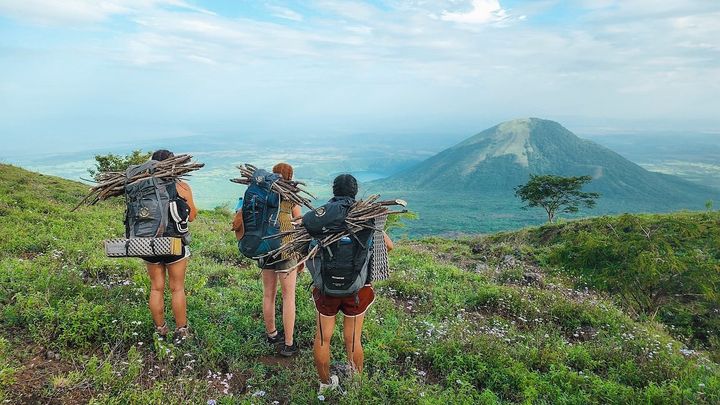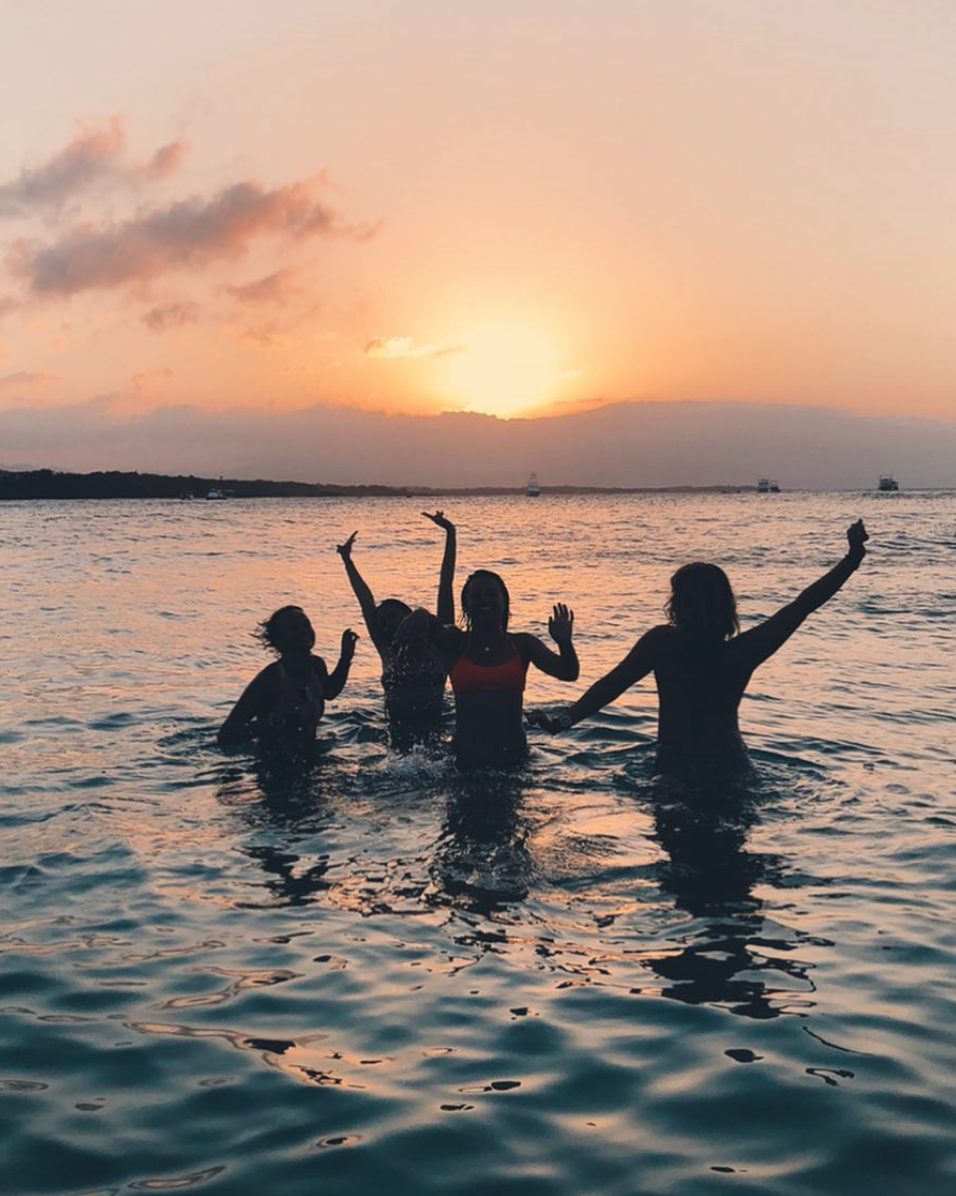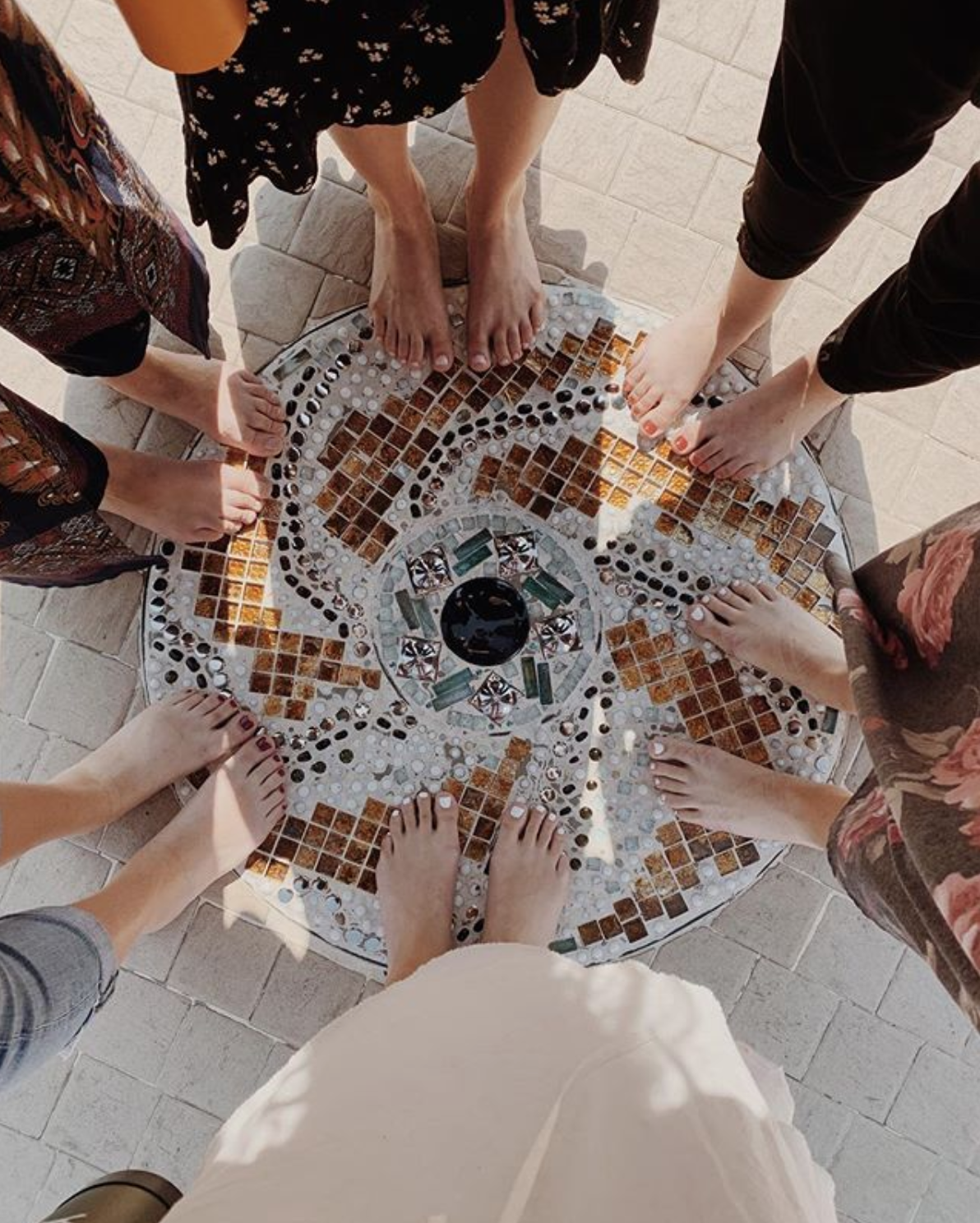
The newest technology in communication is making things much more convenient for international travelers. It's just one more option for staying connected while you're abroad — here's everything you need to know.
You absolutely can travel without phone data by just jumping online whenever you're connected to WiFi. I've lived abroad for months at a time doing that! Not buying a data plan is a way to save a little bit of money. Since those days though, I've done trips with a data plan and honestly, I won't ever do another without it. It's just way too convenient and pretty affordable. It's worth the cost in my opinion.
All The Tips For Travelers
We've got all kinds of tips for your trip like this right here
Don't get overwhelmed — using your phone while you're traveling all over the world is actually really pretty simple and eSIMS just made it even easier!
- What is a SIM
- What is an eSIM (+ compatible devices)
- Comparing SIM VS eSIM
- Your options for using your phone abroad
- Setting up your eSIM
First, Understand What A SIM Is
Have you heard the term SIM card before? It's a tiny card that slips into your phone, essentially a memory chip that stores all of your information. Carriers like Verizon and T-Mobile use it to track your phone calls and texts—it's how your data usage shows up on your cell phone bill each month.

Let's say you sign up for a plan through Verizon and buy your phone through them as well. They're going to install a Verizon SIM card in your phone for you so that you can start using your plan. You can't use Verizon data unless you've got that SIM.
But what if you want to use a different carrier and still keep that same phone ... is that possible? Yes! As long as your phone is unlocked*, you can just pop that Verizon SIM card out and slip in a new SIM card for the carrier you're switching to.
*It's critical that your phone is unlocked, though. If you're not sure, check with your carrier. Sometimes phones come unlocked, sometimes they're locked for a certain number of days after you purchase the phone, and sometimes you have to pay off your phone completely before it can be unlocked.
SIMS For Local Data
Volunteers who are part of our semester abroad programs do this a lot. Because an international data plan is usually pretty expensive* (especially for something longer term like living abroad for a few months), it's often much more cost-effective to use a data plan from the country that you're traveling to. And the service is sometimes better too.
So let's say you're traveling to the Dominican Republic to volunteer with us (ILP) for a few months, here's what we usually recommend:
1. Once you arrive in the DR, purchase a local SIM (usually found at places like the airport and convenience stores).
2. Take your current SIM out of your phone, store it somewhere safe, and replace it with the new local SIM. Pause your plan with your American carrier.
3. Reload your local SIM as needed with more data during your trip.
4. When you head back to the US or Canada, resume your plan with your American carrier and pop your original SIM card back into your phone.
But hold on just a second because there's a new option — eSIMs.
*International rates depend on your carrier, so best to check on your current plan. For example, T-Mobile users typically have international data included!

Technology Is Switching To eSIMs
When Apple released their line of iPhone 14s in September 2022, it came with a bombshell: they were saying goodbye to physical SIM cards and introducing eSIMs.
An eSIM essentially works the same way — it's just the electronic version of a SIM card.
So if you have a newer phone like the iPhone 14 or later, you don't have that tiny slot on the side of your phone where you slip a SIM card in and out. You're using an eSIM instead. More on this below, but rather than using a physical card, you'll just download an app and manage your plan right from your phone!
Only some phones work with an eSIM
You'll want to double-check on your particular device before you plan on going the eSIM route. We're still phasing into eSIM technology, so there will be a period of time where it works for some devices, but not all.
Here's a quick glimpse at typically compatible devices:
- Apple iPhone XS, XS Max, XR, 11, 12, 13, 14, 15, and newer models
- Google Pixel 3, 4, 5, 6, 7, 8, 9, and newer models
- Samsung Galaxy S20, S21, S22, S23, S24, and newer models
- Huawei P40, and newer models
What if I have an older phone that still uses physical SIM cards, or my phone isn't supported for eSIMs?
If your phone was released in 2021 or earlier, you likely have a phone that takes a physical SIM card. Although everyone is projecting that the world is going to start moving to eSIMs, it takes a while for older technology to phase out. There will likely be years to come where local SIMs are still sold at stores around the world and that is still a great option.
But because it's electronic, the beauty of the eSIM is that you can use it on (most) any phone. You can even use a physical SIM and an eSIM at the same time. So lucky you because you have the option of using either! You do need to check and make sure that your device is compatible with an eSIM though. Just like with physical SIMs, your device usually needs to be unlocked and paid off, but this is all determined by your original carrier. So if you currently have AT&T, just talk to them and make sure that your device can take either a new physical SIM or an eSIM.

eSIM VS Physical SIM
So is there a difference? Is one better than the other? What does that mean for me?
Pros for an eSIM
Well for one, eSIMS are insanely convenient, especially for travelers who are navigating a new country and who don't speak the local language. You can have data the minute you step off the plane! Just get your eSIM all set up the night before you depart and then switch your eSIM on once you land.
And it's convenient during your trip too because instead of heading down to the local shop every week or two to add more data, you can do it all right from your phone. With SIMs and eSIMs it's typically for a shorter period of time (like a week to a month), so you need to reload your data every so often if you want to extend your use.
Depending on the app you use, there's typically customer service that you can reach out to if you need support. That's generally not the case if you're purchasing a physical SIM from a tiny shop down the road in Costa Rica.
Sometimes the data is more flexible than what is covered with a local SIM plan.
Technology is just opening up to the world of eSIMs, so we're likely to see more and more improvements.
Pros for a physical, local SIM
If you've currently got an older phone and you were trying to decide if you wanted to upgrade to a new phone before your trip, you might want to hold off because there are still some advantages to that physical SIM.
The type of plan you can get is going to be the biggest difference, as well as the cost. Prices and plans are going to vary wildly depending on the country you're going to, but in general, we're finding that physical SIM cards purchased in the local country are currently the cheapest option.
Here's a quick example — if you're heading to Nicaragua, our ILP volunteers have been purchasing local SIM cards at shops just a few minutes from their house that cost around $5 USD for two weeks of 7.2GB of internet, and 150 minutes of SMS and calling. In comparison, we've found an eSIM plan for $15.50 that gives 2GB of data for two weeks. The price does get a bit cheaper if you purchase a month's worth of time, but it's essentially double the price of a physical SIM purchased in country.
The other thing is that the service on these local, physical SIMs tends to be the best. We've tried out a few eSIMs in a few different countries and we thought local SIMs tended to win out on the better service award.

So Let's Break Down The Options
Okay, that was a lot of information! Is your head spinning?
Let's simplify it. You're about to fly across the world on the trip of a lifetime and you're deciding what to do with your phone and how to stay in touch. Here are your options:
1. Don't buy a data plan and go off the grid. This isn't our recommendation, but it's an option to know about. It saves you some money and lets you disconnect a little bit during your trip. You're not anxious about wandering a new city without being able to look up directions and you know you'll just check in with mom whenever you're connected to WiFi, so you're okay without it. Plus, you can always decide later on during your trip if you want to get a plan after all.
2. Use your American carrier's international data plan. Your parents want to know that they can call you whether you're connected to WiFi or not, so they think it's worth it even though it's more expensive (or maybe it's already included in your plan!). Just know the service can be hit and miss ... data, while you're out and about, is typically much slower than what you're used to in the States, but you have international calling and texting (which isn't the case with local plans).
3. Get a physical, local SIM card once you arrive in the country. It's really affordable! Keep in touch with family and friends over WhatsApp while you're out walking around the city, or over FaceTime while you're connected to WiFi. If you're an ILP volunteer, we usually have tips from past volunteers and local staff who can help you figure out how to purchase one, so don't worry about that. But remember, your phone has to have a slot for a physical SIM (phones as new as late 2022 usually won't work, including iPhone 14 and newer).
4. Download an eSIM app. You either can't get a physical, local SIM or you just like the convenience of doing it all from your phone. Maybe you're planning on getting a physical SIM the first week or two after you arrive in country, but you want to know you have data the minute you step off the plane so you set up a week's worth of eSIM data before you depart. Either way, this is a quick, easy, and immediate way to get data. And it's still much more affordable than purchasing an international plan from a carrier like Verizon.
5. You do a combination of things. The truth is that service while you're abroad is just going to be hit and miss no matter what you do. It's just different depending on the location and your provider, so you might want to try out different options to see which one provides the best service for the price. Maybe you use a carrier like T-Mobile that already includes international data in your current plan (lucky you!). But you find that T-Mobile's service is pretty slow while you're volunteering on the little island of Vanuatu. So you keep your T-Mobile SIM in so that you can call home with international calling, but you also sign up for an eSIM because you've found that you can scroll Instagram faster on the bus when you're switched over to that plan. Or maybe you're planning on using an eSIM while you're volunteering in the Dominican Republic, but once you get there you realize your travel buddies that are using the physical, local SIMs are getting better service, so you decide to let your eSIM plan run out and then go purchase a local one with them instead.
We are big fans of having data while you're abroad. Aside from it just being nice to have, it's also good to have a backup plan if you're ever in an urgent situation. And if you do find yourself in a situation where you need it, it'll feel more than worth every penny you spent on it. But there are a few options and we get mixed reviews on which is best, so you've just got to play around and see which one works best for you.

How To Set Up An eSIM
Find the right app for your destination
It's as easy as downloading an app, choosing between plan options, and paying right in the app.
The tricky part is deciding which app you want to use though because there are several options. Here are a few things you want to look for:
- 1. Your Destination — Not all apps provide service in every country, so the absolute first thing you want to do is head to their site and search to see if they have a plan for the country you're heading to. Most feature "global" plans, but just ignore that. You want to see if they have a plan in your specific country.
- 2. Plans — Compare the prices, but also look at what's offered for that price. You might be paying a little bit more in one app for an unlimited data plan, or maybe you don't need unlimited so you're okay paying less for 1 GB. Maybe you want to try a plan for one week to see how the service is before jumping into their month-long commitment.
- 3. Reviews — Head to the app store and spend a few minutes looking at the reviews. Does anyone mention how the service is in your country? Does anyone talk about how helpful (or not helpful) customer service was?
Use this site to compare
This handy website was recommended by an ILP alumni! They travel a lot internationally and say that it has the best prices and internet options. You can sort through some of the different phone plan options here, and it covers all ILP locations!
You can also search by destination on this website and it will pull up eSIM plans for you to compare. You can even sort by the cheapest plans or the best price/GB!
One quick warning though — it will include eSIMs that market themselves as having a "global" plan. That doesn't mean that they have service in the destination you're going to though, so skip past the ones that say Global and look for ones that say your specific country. So here's what I found looking for an eSIM for the Dominican Republic ... I'm going to consider that first one from Yesim, but I'm just going to ignore those next two because I'm not looking for a Global plan. Keep scrolling down the results from your search because there are several more to consider!

A few apps to consider
Here's a list of options you might want to try out. Because this technology is so new, just know that it's still improving. Some apps might have better or worse service depending on the country you're in. The prices are also going to range, so make sure to compare!
Airalo — this one is pretty popular and will usually pop up first anytime you're researching eSIMs. There are currently 10,000 nearly 5 star reviews in the app store. They offer a variety of plans ranging from a week to a month, but none of those plans have unlimited data. We have a lot of ILP volunteers who still use physical SIMs, but for the ones that use an eSIM, it seems like Airalo is their most popular choice.
We've tried Airalo out in a handful of countries recently. Our review? The service was hit and miss depending on the country (as it goes with most plans). It was pretty slow while we were in India, but volunteers have said great things about using it in Costa Rica. But again, Airalo seems to be the most popular eSIM amongst travelers at this point in time across the board.
It looks like Airalo currently offers a plan for all ILP locations at the time this post was written, but you'll want to double-check to see if anything changes.
eSIM Plus — No plan in Vanuatu
Nomad — Plans for all ILP countries
Yesim — Plans for all ILP countries
Redteago — No plan for Vanuatu or Uganda
Ubigi — No plans in Vanuatu or Uganda
Flexiroam — Plans for all ILP countries
How it works
Once you choose a plan that looks good, just download the app and it's pretty easy from there. You'll purchase your plan within the app and manage everything from there. You can turn it on and off as needed (although remember if you pick a plan that expires after a certain period of time you'll want to use up your data during that time). There's also typically customer service if you're having any issues.

Get More Support While You're Traveling Abroad
We are International Language Programs — we're a nonprofit org out of Utah that arranges semester abroad type experiences for college-age young adults. You get to live abroad for a few months with a group of new friends, do some volunteering, and have lots of free time to explore! It's just enough time to really dive into the culture and feel like this foreign country becomes a second home.
We offer lots of support from step A to Z, so it's an awesome match for someone who doesn't have experience traveling and doesn't want to do a solo trip. We'd love to chat if you have any questions about how it all works!
















